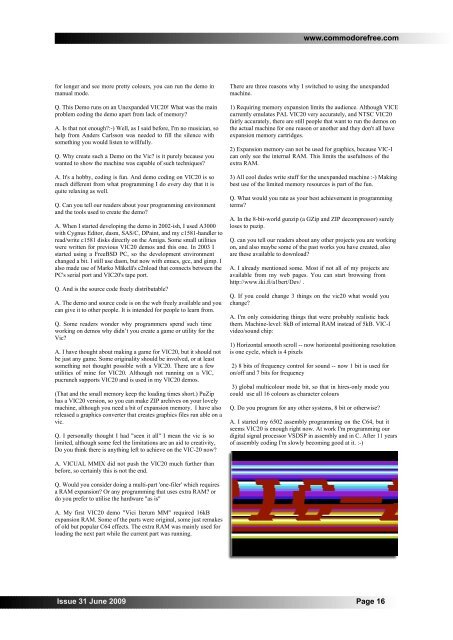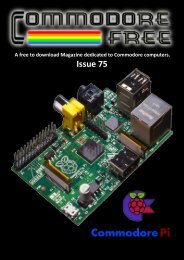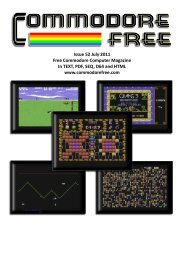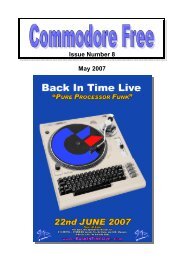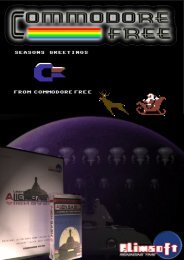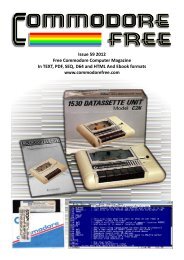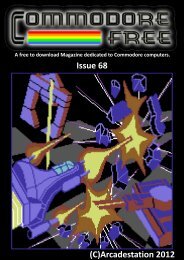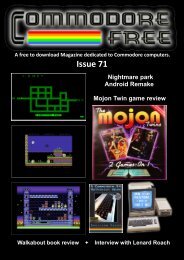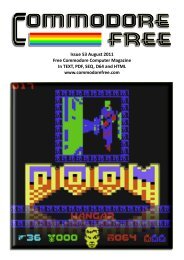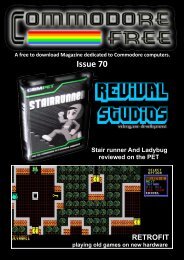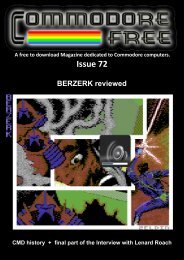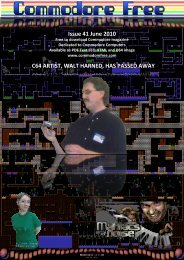Commodore Free issue 31.pdf - 3002 KB
Commodore Free issue 31.pdf - 3002 KB
Commodore Free issue 31.pdf - 3002 KB
Create successful ePaper yourself
Turn your PDF publications into a flip-book with our unique Google optimized e-Paper software.
www.commodorefree.com<br />
for longer and see more pretty colours, you can run the demo in<br />
manual mode.<br />
Q. This Demo runs on an Unexpanded VIC20! What was the main<br />
problem coding the demo apart from lack of memory<br />
A. Is that not enough:-) Well, as I said before, I'm no musician, so<br />
help from Anders Carlsson was needed to fill the silence with<br />
something you would listen to willfully.<br />
Q. Why create such a Demo on the Vic is it purely because you<br />
wanted to show the machine was capable of such techniques<br />
A. It's a hobby, coding is fun. And demo coding on VIC20 is so<br />
much different from what programming I do every day that it is<br />
quite relaxing as well.<br />
Q. Can you tell our readers about your programming environment<br />
and the tools used to create the demo<br />
A. When I started developing the demo in 2002-ish, I used A3000<br />
with Cygnus Editor, dasm, SAS/C, DPaint, and my c1581-handler to<br />
read/write c1581 disks directly on the Amiga. Some small utilities<br />
were written for previous VIC20 demos and this one. In 2003 I<br />
started using a <strong>Free</strong>BSD PC, so the development environment<br />
changed a bit. I still use dasm, but now with emacs, gcc, and gimp. I<br />
also made use of Marko Mäkelä's c2nload that connects between the<br />
PC's serial port and VIC20's tape port.<br />
Q. And is the source code freely distributable<br />
A. The demo and source code is on the web freely available and you<br />
can give it to other people. It is intended for people to learn from.<br />
Q. Some readers wonder why programmers spend such time<br />
working on demos why didn’t you create a game or utility for the<br />
Vic<br />
A. I have thought about making a game for VIC20, but it should not<br />
be just any game. Some originality should be involved, or at least<br />
something not thought possible with a VIC20. There are a few<br />
utilities of mine for VIC20. Although not running on a VIC,<br />
pucrunch supports VIC20 and is used in my VIC20 demos.<br />
(That and the small memory keep the loading times short.) PuZip<br />
has a VIC20 version, so you can make ZIP archives on your lovely<br />
machine, although you need a bit of expansion memory. I have also<br />
released a graphics converter that creates graphics files run able on a<br />
vic.<br />
Q. I personally thought I had "seen it all" I mean the vic is so<br />
limited, although some feel the limitations are an aid to creativity,<br />
Do you think there is anything left to achieve on the VIC-20 now<br />
There are three reasons why I switched to using the unexpanded<br />
machine.<br />
1) Requiring memory expansion limits the audience. Although VICE<br />
currently emulates PAL VIC20 very accurately, and NTSC VIC20<br />
fairly accurately, there are still people that want to run the demos on<br />
the actual machine for one reason or another and they don't all have<br />
expansion memory cartridges.<br />
2) Expansion memory can not be used for graphics, because VIC-I<br />
can only see the internal RAM. This limits the usefulness of the<br />
extra RAM.<br />
3) All cool dudes write stuff for the unexpanded machine :-) Making<br />
best use of the limited memory resources is part of the fun.<br />
Q. What would you rate as your best achievement in programming<br />
terms<br />
A. In the 8-bit-world gunzip (a GZip and ZIP decompressor) surely<br />
loses to puzip.<br />
Q. can you tell our readers about any other projects you are working<br />
on, and also maybe some of the past works you have created, also<br />
are these available to download<br />
A. I already mentioned some. Most if not all of my projects are<br />
available from my web pages. You can start browsing from<br />
http://www.iki.fi/a1bert/Dev/ .<br />
Q. If you could change 3 things on the vic20 what would you<br />
change<br />
A. I'm only considering things that were probably realistic back<br />
them. Machine-level: 8kB of internal RAM instead of 5kB. VIC-I<br />
video/sound chip:<br />
1) Horizontal smooth scroll -- now horizontal positioning resolution<br />
is one cycle, which is 4 pixels<br />
2) 8 bits of frequency control for sound -- now 1 bit is used for<br />
on/off and 7 bits for frequency<br />
3) global multicolour mode bit, so that in hires-only mode you<br />
could use all 16 colours as character colours<br />
Q. Do you program for any other systems, 8 bit or otherwise<br />
A. I started my 6502 assembly programming on the C64, but it<br />
seems VIC20 is enough right now. At work I'm programming our<br />
digital signal processor VSDSP in assembly and in C. After 11 years<br />
of assembly coding I'm slowly becoming good at it. :-)<br />
A. VICUAL MMIX did not push the VIC20 much further than<br />
before, so certainly this is not the end.<br />
Q. Would you consider doing a multi-part 'one-filer' which requires<br />
a RAM expansion Or any programming that uses extra RAM or<br />
do you prefer to utilise the hardware "as is"<br />
A. My first VIC20 demo "Vici Iterum MM" required 16kB<br />
expansion RAM. Some of the parts were original, some just remakes<br />
of old but popular C64 effects. The extra RAM was mainly used for<br />
loading the next part while the current part was running.<br />
Issue 31 June 2009 Page 16


